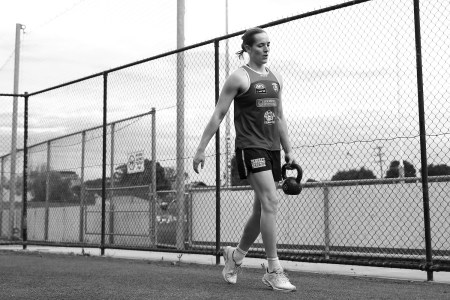Legendary Italian freediver Umberto Pelizzari used to train in the Red Sea to study the breathing habits of dolphins.
He was intrigued by dolphins’ unique method for conserving their oxygen; whenever they dove for extended periods, they’d manage to slow down their heart rates and cling to a consistent core temperature. Pelizzari was keen to replicate these clever physiological adaptations in his own freediving.
If dives of nearly 500 feet underwater are any indication, he figured it out. Pelizzari was also a pioneer in static apnea training, a discipline in which a freediver holds their breath for as long as possible without any movement. Intense fare, but he approached it with an uncommon zen. Pelizzari once said: “The scuba diver dives to look around. The freediver dives to look inside.”
Pelizzari aimed for preparedness and efficiency in his dangerous dives. But he prized relaxation. Like his dolphin peers, he understood that challenges had to be met with calm, confidence and control.
The Essential “Longevity Lift” That Everybody Skips
Suitcase carries supercharge the core. Here’s the best way to pencil them in.At their core, Pelizzari and the many freedivers who’ve come along since him in the last three decades are masters in breath. Little wonder that they perform yoga and meditate. They’ll do whatever it takes to improve their breath control — and by extension, their capacity to survive in a dangerous environment like the ocean’s twilight zone.
By now, you’ve probably heard of breathing exercises for every anxiety or malady under the sun. Try this string of inhales to beat insomnia, put that finger on that nostril to cure depression, etc. They all blur together, which makes them easy to discount, or forget about, or never make time for.
But the truth is, breathwork works. It’s really good for you, and it really does have a wide variety of use cases. Breathing exercises can make it easier to fall asleep, or stick with running, or keep your calm in traffic. None of those situations, on their own, are as fraught as diving into the deep sea. But tallied over the course of a life, they can all take their toll.
Top 10 Breathing Exercises
Below, a definitive guide to cut through all the scattershot coverage on breathwork. We’ve assembled 10 exercises, and we’ve sampled them all. From pursed-lip breathing to breath of fire, each one is capable of working wonders if you’ll let them. Consider this breathwork toolkit, to be used accordingly as you visualize your next move, channeling calm, confidence and control all the while.
1. Box Breathing
What it is: A pretty famous technique, which is also known as square or four-sided breathing, box breathing is intended to reduce stress and anxiety.
When to use it: Whenever you’re feeling overwhelmed or anxious. Inhale for a count of four, hold your breath for four counts, exhale for four counts, and hold again for four counts. Repeat this cycle for several minutes to calm down your nervous system.
2. Diaphragmatic Breathing
What it is: This is the big one. Also known as belly breathing, this technique engages the diaphragm, the primary muscle responsible for efficient breathing. This technique not only improves oxygen intake but also activates the core muscles, encouraging all-around fitness.
When to use it: Ideally, you’ll want to practice diaphragmatic breathing daily to enhance lung function and core stability. Sit or lie down comfortably and place one hand on your chest and the other on your abdomen. Inhale slowly through your nose, allowing your belly to rise while keeping your chest still. Exhale slowly through your mouth, and feel your belly lower.
3. Alternate Nostril Breathing
What it is: A yogic breathing technique that’s said to balance the body’s energy and calm the mind.
When to use it: You don’t need to save this one for a yoga class. Whenever you need a bit of mental focus, close your right nostril with your right thumb and inhale through your left nostril. Close your left nostril with your right ring finger, release your thumb, and exhale through your right nostril. Inhale through the right nostril, close it, and exhale through the left nostril. Continue this pattern for several minutes.
4. Pursed-Lip Breathing
What it is: This technique can improve lung function and exercise endurance by increasing the oxygen exchange in your lungs.
When to use it: Incorporate pursed-lip breathing into activities like jogging, swimming, or cycling. Inhale slowly through your nose, then exhale through pursed lips, as if you’re blowing out a candle. (Keeping the exhale “controlled” helps maintain airway pressure.)
You Should Try Deep Breathing to This Spotify Playlist
Getting into a diaphragmatic habit is easier with musical accompaniment5. 4-7-8 Breathing
What it is: Another technique that’s trumpeted on social media all the time, meant to quiet the mind, relax the body and make it easier to fall asleep.
When to use it: Prioritize 4-7-8 breathing for when you’re struggling with insomnia. Inhale for a count of four, hold your breath for a count of seven, and then exhale for a count of eight. Repeat this cycle three more times, and you might find yourself drifting off to dreamland.
6. Breath of Fire
What it is: A rapid, rhythmic breathing technique, popular in Kundalini yoga, which many practice to invigorate the body and mind.
When to use it: Practice breath of fire for up to three minutes (see how a minute feels to start) whenever you need an energy boost. With your mouth closed, take short, quick breaths in and out through your nose, focusing specifically on the exhale.
7. Lion’s Breath
What it is: A technique on the more playful side (maybe try this one with kids), designed to relieve facial tension, improve circulation and lighten your mood.
When to use it: Whenever you’re feeling stressed or tense, inhale deeply through your nose, then exhale forcefully through your mouth while extending your tongue and making a “HA” sound.
8. Sitali Breath
What it is: A cooling technique that can help lower your body temperature.
When to use it: Practice this one after an intense workout or on a hot day to cool down. Stick your tongue out and curl the sides to form a tube. (It’s easier than it sounds). Inhale through the tube, drawing in cool air, then close your mouth and exhale through your nose. Repeat this process for several minutes to experience a refreshing effect.
9. Resonant Breathing
What it is: Also known as coherent breathing, the technique helps synchronize your heart rate and respiration in the name of relaxation.
When to use it: Practice resonant breathing whenever you need to unwind or relax. Inhale slowly for a count of five, then exhale slowly for a count of five. Maintaining this five-second, inhale-exhale pattern creates a breathing rate of six breaths per minute, which is believed to optimize cardiovascular function and promote relaxation.
10. Breath Retention
What it is: Also known as kumbhaka, it’s a technique used in yoga and meditation practices to increase focus, mental clarity and self-awareness.
When to use it: Practice breath retention whenever you want to improve your concentration and ability to stay present. Inhale deeply and hold your breath for a comfortable length of time, then exhale slowly and completely. Pause for a moment before your next inhale, and repeat the cycle.
The Charge will help you move better, think clearer and stay in the game longer. Subscribe to our wellness newsletter today.



























